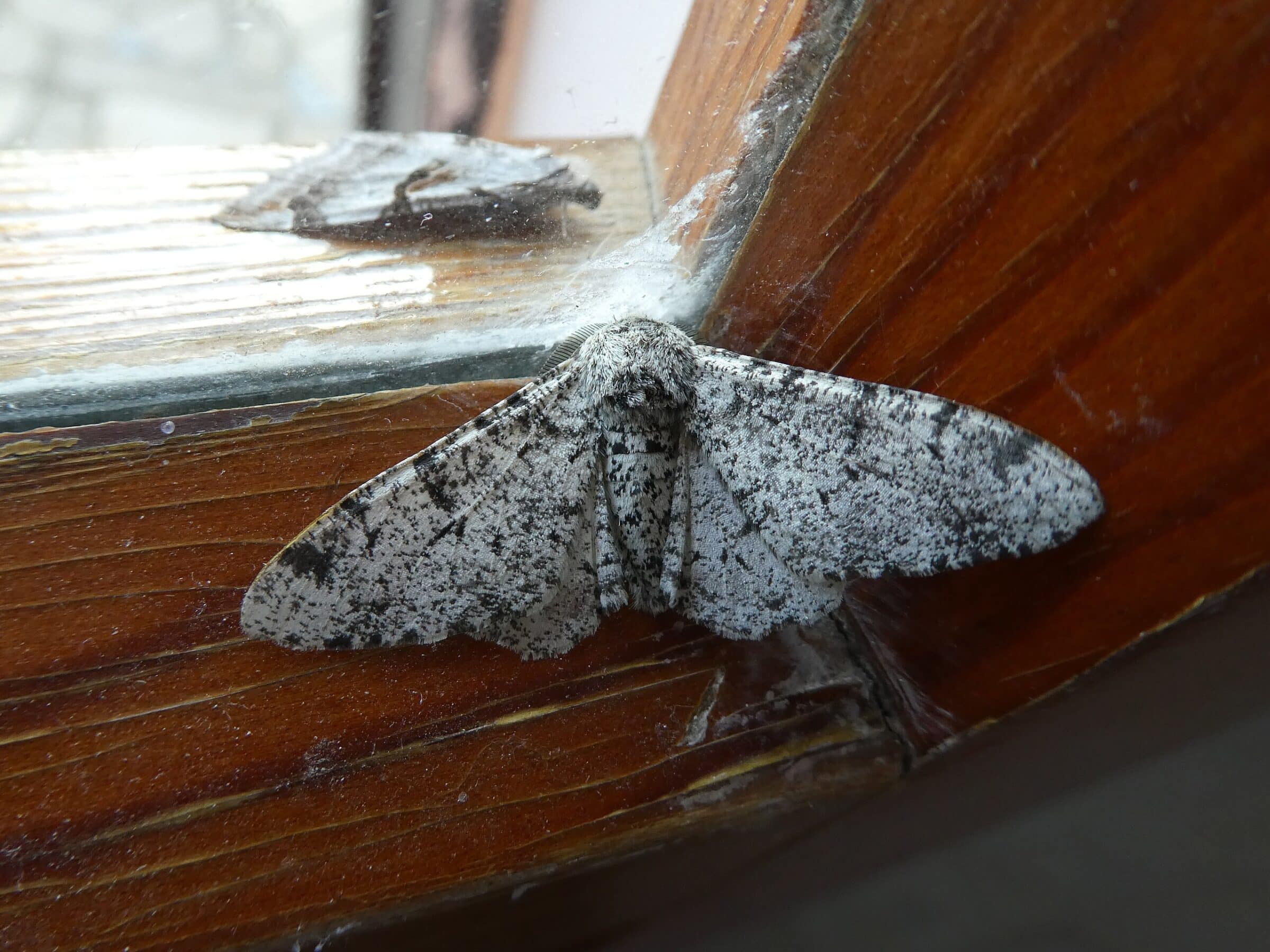A new article at IFL Science is titled, “‘One Of The Most Beautiful Experiments In Evolutionary Biology’: What The Peppered Moth Taught Us About Evolution.” It touts the famous moth as an example of evolution and even uses it to attack what it calls “fundamentalist Christians.”
What’s going on here? According to the classic story, originally the moth species Biston betularia in Britain was dominated by individuals with light-colored wings. However, during the industrial revolution, soot covered the trees and it became more advantageous to be a dark-colored moth which could blend in with the soot and avoid predation by birds. The story has been retold in countless textbooks, and peppered moth expert and researcher Michael E. N. Majerus once called it “an excellent teaching example of Darwinian evolution in action.” Or was it?
Our late colleague Jonathan Wells wrote about the peppered moth in his 2000 book Icons of Evolution and again in his 2017 book Zombie Science. He cited research published in mainstream scientific journals showing that peppered moths may not normally rest on tree trunks, that photos of moths on tree trunks were staged, and that they may not even be commonly eaten by birds. The whole textbook story was called into doubt. However, later research has claimed to rehabilitate parts of the original tale. The IFL Science author, Dr. Katie Spalding, writes as if the classical story is completely supported by evidence, despite the fact that Wells cited mainstream research to support his case.
Small-Scale Evolution
When I first read about the peppered moth in Icons of Evolution, I remember immediately thinking, “The peppered moth story has problems, but on the surface at least it sounds plausible, so let’s consider the possibility that it’s true. Even if we grant for the sake of argument that the whole story is true, this is still nothing but extremely small-scale microevolution!” In the best case for the peppered moth story, you start with a moth from the species Biston betularia, and you end with a moth from the species Biston betularia. All you’ve done is shift the proportion of light vs. dark scales on the wings to make some moths appear lighter or darker colored than others. If this is an “excellent” example of “Darwinian evolution in action,” it shows that Darwinian evolution doesn’t do very much.
Indeed, Jonathan Wells saw things much the same way. Wells wrote much about the peppered moth after publishing Icons of Evolution. In a 2016 blog post he wrote:
Of course, even if the classic story were true, it would not demonstrate Darwinian evolution. Darwin didn’t write a book titled How Existing Species Change Over Time. He wrote a book titled The Origin of Species. His argument was that natural selection produces entirely new species, organs, and body plans. A temporary shift in the proportions of light- and dark-colored peppered moths is irrelevant to that argument.
I’ve long taken a similar view. In fact, my approach to the peppered moth story has always been to say that I’m willing to grant, at least for the sake of argument, that the whole story may be true. It still doesn’t show anything interesting about the creative power of evolution.
Attempts to Rehabilitate the Peppered Moth Story
After writing Icons, Wells reported on various attempts to rehabilitate the peppered moth story. In Zombie Science, which Wells published in 2017, he noted that peppered moth researcher Michael Majerus had claimed the moths do in fact rest on tree trunks where they are eaten by birds. Majerus tried to turn this into some kind of an argument against religion:
From 2001 to 2006, Majerus studied peppered moths in a large, unpolluted rural garden about sixty miles north of London. He began by climbing a few trees, where he counted 135 moths resting on trunks, branches, and twigs. Of these most were on branches, but forty-eight (thirty-six percent) were on the trunks.
Majerus conceded that his “results may be somewhat biased towards lower parts of the tree, due to sampling technique.” Brits are known for understating things, but this deserves a place in the Understatement Hall of Fame. Since Majerus’s goal was to find out where peppered moths normally rest, and biologists had already concluded that they probably rest in the higher branches of trees, Majerus should have found a way to survey those higher branches, not just the ones he could reach by climbing up a tree from the ground. He could have built some scaffolds, or he could have rented a hydraulic aerial work platform. As it is, his technique was a bit like counting fish in the ocean from the deck of a boat and concluding that most of them live within ten feet of the surface.
Over the course of six years, Majerus artificially released almost five thousand light and dark moths onto the trees. He would release a few moths each night into netting sleeves he had placed around selected branches, then he would remove the sleeves before dawn and note the branches on which moths had come to rest. Four hours later he would count those still on the branches. In four of the six years, more dark moths disappeared than light ones.76 He concluded that those he couldn’t find had been eaten by birds. Majerus did observe some moths actually being eaten by birds, but he assumed all moths that disappeared had been eaten by birds and that none that disappeared had simply moved to a different location.
Despite his obvious sampling bias — and his unsupported assumption that all disappearing moths had to have been eaten by birds — Majerus confidently interpreted his findings as evidence for the classic Darwinian story of evolution. Thus, when Majerus presented his results in 2007, he urged the teaching of the peppered moth story again because “It provides after all: The Proof of Evolution” (boldface by Majerus).
It didn’t, of course, but Majerus clearly wanted it to. At one point in his presentation he revealed why, declaring out of the blue that humans invented God and that there will be “no second coming; no helping hand from on high.”
pp. 65-66
Wells responded to many other critics over the years (see for example here, here, and here) — again, always full of citations to the mainstream scientific literature. And Wells wasn’t the only critic: he once recounted that “On October 15, 2002, the New York Times (p. D1) featured the photographs as an egregious example of ‘scientific fakery.’”
Overstating the Evidence
Now, the IFL Science writer wants to follow in the tradition of Majerus by trying to rehabilite the peppered moth story and turn it into an argument against religion. The opening framing of the article makes it sound like the peppered moth is evidence for much grander types of evolution:
Despite the wealth of evidence supporting it, its obvious sense as an explanation, and its endorsement by many and varied religious institutions, there are some people out there who still don’t accept the theory of evolution. Sure, they sometimes say, fossils might be real; there are animals that once existed that no longer do — but if one species could really become another, wouldn’t we be able to see it happening?
Lesser advocates might point out that no, evolution is a long-term process built off the back of myriad imperceptible changes at the genetic level, eventually building up enough to affect an entire population. But we’ve got a better counterargument, and it’s this: that you can see it happen — and what’s more, somebody kind of did.
So if you can “see it happen”, what is “it” that we’re seeing? According to the article, it seems to be not just the idea of evolution but the possibility that “one species could really become another.” I’m sorry, but even in a best-case scenario, that is absolutely not what we’re seeing in the peppered moth story. I like how Cornelius Hunter put it here at Science and Culture Today:
[C]hanging colors is hardly a pathway leading to the kinds of massive biological change evolution requires. It is not as though a change in the peppered moth coloration is any kind of evidence for how the moths evolved, or how any other species, for that matter, could have evolved.
Or let’s give Jonathan Wells another chance to comment, from a 2022 blog post:
Yet even if the classic peppered moth story were 100 percent true, it would not be proof of Darwinian evolution, much less of the human invention of God. At most, the story shows a change in the proportions of two varieties of the same species. If Darwin had written a book titled How Existing Species Change Over Time, the peppered moth story would be relevant. But Darwin wrote a book titled The Origin of Species, because he thought he had discovered the mechanism whereby unguided natural processes could produce not only new species, but also new organs and body plans. The peppered moth story doesn’t come close to proving any of that.
Given the weakness of what the peppered moth shows even in a “best-case scenario,” why do our friends in the pro-Darwin world feel it’s so important?
Bashing “Fundamentalist Christians”
The IFL Science writer seems to be aware that the peppered moth isn’t all that impressive an example of Darwinian evolution, because she apparently feels the need to bash religion and use rhetoric to compensate for less-than-compelling evidence:
Well, the problem with such a clear demonstration of natural selection in action is that it makes it really hard to defend pure creationism — so, rather than adjust their worldview based on evidence, fundamentalist Christians attacked the peripheries.
This is simply bizarre, and certainly out of touch with what Darwin-critics have been saying for a long time. I’m not sure what “pure creationism” is but nobody I’ve ever met in the ID or creationist communities denies that natural selection is a real force in nature. Everyone has always agreed that natural selection happens and can do things. The evidence, though, only shows that it causes small-scale changes. In fact, shifting frequency of dark vs. light scales on moth wings is precisely the sort of small-scale change that we think natural selection can effect. But producing large-scale changes appears to be beyond the reach of the classical mutation-selection mechanism.
What Does the Literature Say?
Meanwhile, just as IFL Science is pretending that “fundamentalists Christians” who defend “pure creationism” are cowering in fear of slight changes in the coloration of moth wings, a new paper in the journal Frontiers in Ecology and Evolution acknowledges the limits of classical Darwinism:
Darwinian evolution has provided a robust framework for understanding biological change for more than 150 years. Natural selection acting on heritable variation remains one of the most powerful and empirically validated explanations for microevolutionary dynamics — the emergence of small-scale adaptations within species (Endler, 1986; Futuyma, 2013). Classic cases such as antibiotic resistance in bacteria or beak diversification in Darwin’s finches confirm the power of mutation and selection to shape traits within populations over relatively short timescales (Grant and Grant, 2008; Davies and Davies, 2010).
However, macroevolutionary transitions — such as the origin of new lineages, adaptive radiations after mass extinctions, and the persistence of ancient alleles across deep time — often unfold faster and at scales that mutation and vertical inheritance alone cannot fully explain (Gould and Eldredge, 1977; Lynch, 2007). [Emphasis added.]
I along with the vast majority of ID proponents would 100 percent agree with everything this paper just said. And so would a lot of other scientists who make up the growing “Third Way” camp that criticizes neo-Darwinism and looks to non-Darwinian models of evolution. Yes, mutation and selection can cause small-scale changes, but the macroevolutionary origin of new groups and large-scale change is very difficult to explain under classical Darwinism.
We Can See Who Cares
Is the peppered moth story true? Jonathan Wells backed up his criticisms with strong citations to the literature when he wrote Icons and later in Zombie Science, but subsequent research may show that parts of the story are not completely wrong. I really don’t know for sure. But what I do know is what I’ve been saying all along: Even if it is true, at most the peppered moth story only demonstrates very small-scale changes within a species.
So, who really cares? I think this IFL Science article’s overblown rhetoric provides the answer: Darwin defenders care deeply about the peppered moth (and similar evolutionary icons) because, though they represent trivial evidence for the creative power of evolution, they’re the best evidence they’ve got.









































